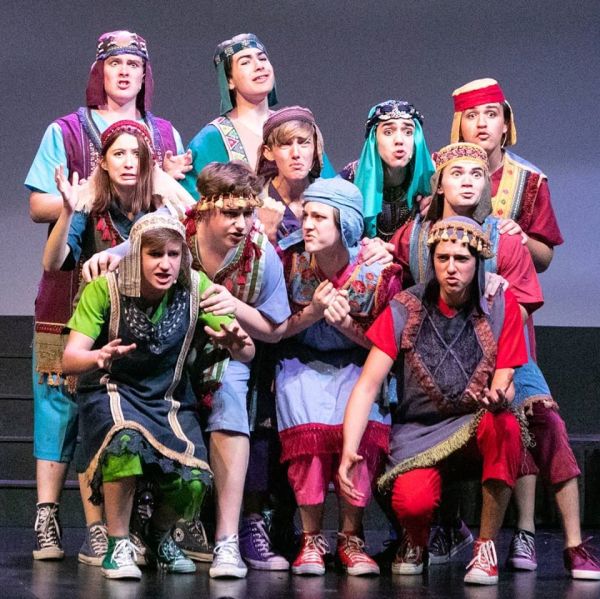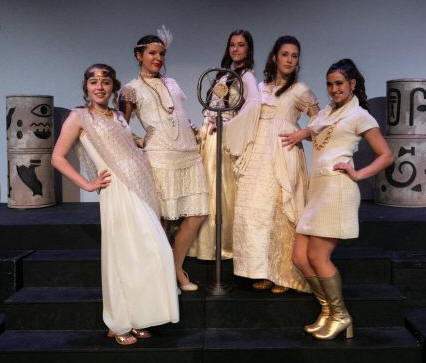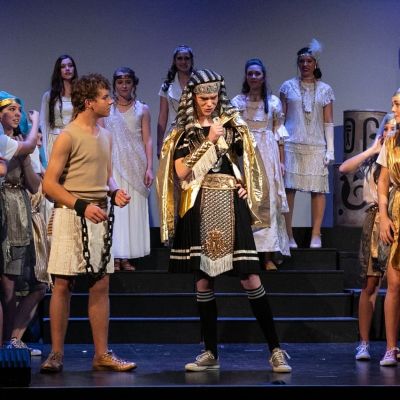Theatre Review
Take Note Troupe
Joseph and the Amazing Technicolor Dreamcoat
I really enjoy Joseph and the Amazing Technicolor Dreamcoat. I’ve seen four productions of the show, and each one has delighted me. I didn’t think I could be surprised by another version, but this show dazzled me: it was just bursting with creativity. The show I saw on this Saturday evening represented an extraordinary degree of planning, creativity, and coordination.
Take Note Troupe pulled it off by applying principles they have developed. In fact, you might call this a missionary organization — not in the religious sense — but in the sense of promoting life skills and community. The key is “happiness,” fostered through the application of what they call “Play Theory.” This is from their website: “Happiness in everyday life can be cultivated through the application of our improv rules, encapsulated in PLAY THEORY. These rules are a part of every class, every workshop, every rehearsal, and every performance that TNT puts on. We strive to practice them both on stage and off. We know that PLAY THEORY makes us better performers who can engage our audience. It strengthens teams. It increases our ability to make the most of every situation and to do our best in whatever we do. Our goal is to change the world one workshop, class, performance, and participant at a time.” There’s more about “Play Theory” in TNT’s website, www.takenotetroupe.org and in www.playtheory.org.
Joseph and the Amazing Technicolor Dreamcoat is a retelling of the Biblical story of the vicissitudes of Joseph that eventually led to him guiding Egypt through famine and reconciling with the brothers who had betrayed him. The story can be inspiring, but it’s the wonderful pop, tongue-in-cheek music by Andrew Lloyd Webber and Tim Rice that carries the show, and TNT’s cast of 50 or so did justice to the music and the humor that are at the heart of Webber’s and Rice’s concept.
The show began when the 20 kids (mostly middle-school age or younger) walked on: performing in pantomime, playing games with each other, staging cute interactions, and generally cavorting around until 11 formed into a children’s choir. They began singing the overture to the show and were soon joined with the full cast.
(Click here to open the program in a new window.)
The principals in this show turned in impressive performances. Henry
Thomas was an excellent Joseph, with a strong, pleasing voice and good
acting skills. And Liam Bailey gave a high-energy Elvis Presley
imitation as Pharaoh. The part of the Narrator was split among 5 young
women, all with good voices and good stage presence. Even though they
weren’t part of the story themselves, these Narrators projected a lot of
personality and gave some of the best singing in the show. Especially
in contrast to Joseph’s family at the beginning, their costumes — all
very different — were elegant and seemed to me to represent
 fashionable
dress from perhaps the 1920s to the present. The eleven brothers and
their wives were something else. They were at the heart of the major
group numbers, and they were a hoot, especially the brothers —
shamelessly overacting and cavorting spontaneously at each opportunity.
They seemed uninhibited in their interpretation of their roles, and
their antics were great fun to watch.
fashionable
dress from perhaps the 1920s to the present. The eleven brothers and
their wives were something else. They were at the heart of the major
group numbers, and they were a hoot, especially the brothers —
shamelessly overacting and cavorting spontaneously at each opportunity.
They seemed uninhibited in their interpretation of their roles, and
their antics were great fun to watch.
As for the rest of the singing, I didn’t hear any “problem” voices among any of the soloists, and when all 50 cast members were singing, it made a big and very pleasing sound, with the clever lyrics easily discernible. But what made these musical numbers work so well was the energy and spirit with which they were performed. “Go Go Go Joseph,” for example, was a major production that got the audience clapping in time to the music. Then in the second act, Liam Bailey and the ensemble gave a great performance in Pharaoh’s big Elvis-inspired numbers. After it was over, Bailey came out with a slurred “thank you very much” à la Elvis, put on a pair of sunglasses, and started the number from the top again. I think we in the audience enjoyed it even more the second time.
This show is really an operetta in that every twist in the plot is sung,
with just a few spoken lines. At the same time, it’s a musical comedy
with a lot of the comedy set up by the songs themselves. I wouldn’t call
them parodies but rather send-ups of different styles: a Western
hoedown, a Parisian cafe, a Jamaican celebration, and the Elvis Presley
show. But there was a lot of variety in the music, and every bit was
listenable, even memorable, and the young players really seemed to
embrace the spirit of each song. At one point I wrote in my notes that
I can't remember seeing so many happy, energetic kids outside of a high
school football game.
There was a lot of good choreography in this show, sometimes enhanced with some pretty impressive acrobatics. In general, it seemed to me that their big musical numbers were tightly and creatively choreographed and were very entertaining to watch. And time and again during the show, it struck me that a lot of thought had gone into the choreography.
It felt like each musical number had clever, creative touches that enhanced the humor. In “Those Canaan Days” when the brothers were lamenting the famine, people brought out trays of food that were only the skeleton of a small animal. In the “Benjamin Calypso” they brought out a limbo bar, and as the number proceeded, many of the younger performers went under it.
Along with sight gags, an important part of this show was calling on the audience to use their imagination — and find the fun in doing so. You had to use your imagination. For a start, the set pieces were minimal. The bare stage had steps leading to an upstage platform where a few decorated columns eventually brought us to Egypt. A construction evocative of prison bars was brought in to suggest Joseph’s imprisonment. Fairly simple projections on the screen at the back of the stage gave desert scenes or whatever was needed to define the place of the action. There were some especially creative props, however, and I was particularly delighted with the 4-person camel.
Throughout the show I got a sense of nearly constant movement. Part of this, it seemed to me came from the current of overacting in the show. As I see it, the lyrics demanded it, and when you give teenagers the liberty to overact, they deliver: no problem. (I'm thinking especially of Joseph's sons' mourning in “One More Angel in Heaven.”) But to me — and to the audience — it was all pure fun. Indeed, this particular audience really embraced the show, laughing often, applauding enthusiastically, even cheering. And when the music for “One More Angel in Heaven” turned into a hoedown, the audience needed no encouragement to start clapping in time to the music as they watched cowboys and cowgirls dancing in pairs.
 Many
of the costumes were simple, but evocative through the choice of
headgear and tunics, though you can see their colorful effect in the
accompanying pictures. Then there were costumes that were truly
impressive, such as Joseph's “coat of many colors” (a work of textile
art), and the costumes of a few key figures like Pharoah or Joseph after
his “promotion.” If you watched the show with no sound at all, you'd
conclude that it was amazingly colorful. Brightly colored fans and
shimmering fabric were used to illustrate different parts of the story
(e.g. Joseph's dream of his brothers' sheaves of corn bowing down to
his). At one point, downstage singers waved colorful streamers to bring
even more color to the song they were performing.
Many
of the costumes were simple, but evocative through the choice of
headgear and tunics, though you can see their colorful effect in the
accompanying pictures. Then there were costumes that were truly
impressive, such as Joseph's “coat of many colors” (a work of textile
art), and the costumes of a few key figures like Pharoah or Joseph after
his “promotion.” If you watched the show with no sound at all, you'd
conclude that it was amazingly colorful. Brightly colored fans and
shimmering fabric were used to illustrate different parts of the story
(e.g. Joseph's dream of his brothers' sheaves of corn bowing down to
his). At one point, downstage singers waved colorful streamers to bring
even more color to the song they were performing.
Indeed, it seemed that there was no end to the creative touches that adorned this show, thanks to the imagination of director LaRee Florence and the creative people who worked with her. One more example came at the end of the intermission in the form of a singalong of the songs from the first half, with the soundtrack playing while words were displayed on the screen behind the stage.
The program identified a reprise of one of the most memorable songs, “Any Dream Will Do,” as the “finale.” But then there was something called the “Mega Mix,” unique to this production, that came off like a high-energy party on stage, with clapping and dancing, and choreographed bows. To me, it felt like it went on forever, with the energy just building and building, until it spilled out into the audience. It was a finale to end all finales, and as the performers ran out to the lobby to connect with audience members, I could see the pure joy in their faces. They had been part of something really special, and they knew it. And all of us in the audience knew it, as well.
(Besides their fall productions, monthly On the Spot Improv shows and numerous other activities, Take Note Troupe performs a Shakespearean play in the spring at both indoor and outdoor venues. Coming May and June 2020 is Much Ado About Nothing. Follow their activities at https://takenotetroupe.org.)
Dick Frantzreb is editor of the Capital Region Performance Gallery. He also edits the Sacramento Choral Calendar and the Placer Performance Calendar, and he was a co-founder and past President of the Sacramento Valley Choral Coalition. He has been loving live performances in the greater Sacramento area and writing about them since 2012.

